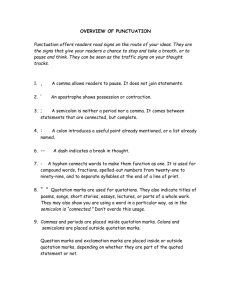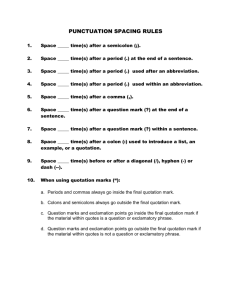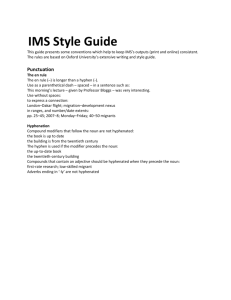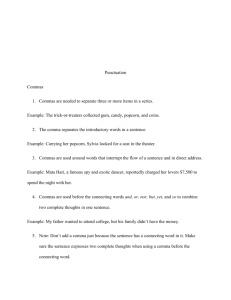Punctuation Review - Falconer Central School
advertisement
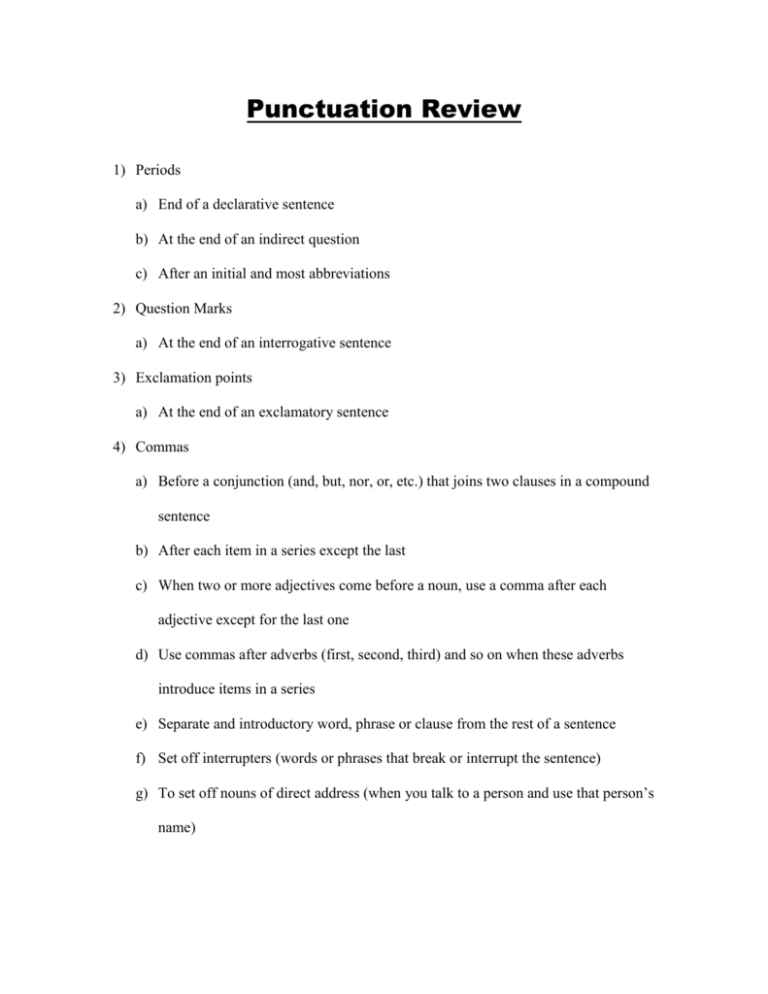
Punctuation Review 1) Periods a) End of a declarative sentence b) At the end of an indirect question c) After an initial and most abbreviations 2) Question Marks a) At the end of an interrogative sentence 3) Exclamation points a) At the end of an exclamatory sentence 4) Commas a) Before a conjunction (and, but, nor, or, etc.) that joins two clauses in a compound sentence b) After each item in a series except the last c) When two or more adjectives come before a noun, use a comma after each adjective except for the last one d) Use commas after adverbs (first, second, third) and so on when these adverbs introduce items in a series e) Separate and introductory word, phrase or clause from the rest of a sentence f) Set off interrupters (words or phrases that break or interrupt the sentence) g) To set off nouns of direct address (when you talk to a person and use that person’s name) h) Set off an appositive (a word or group of words that explain something before it) wrap the appositive in commas i) Set off explanatory words in a quotation j) Place another comma after the last explanatory word in a divided quotation k) After the day of the month when writing dates l) Between the town or city and the name of the state, district, or country m) After the greeting of a friendly letter n) After the closing in any letter 5) Semicolon a) Separate parts of a compound sentence when no conjunction is used b) Before a conjunctive adverb in a compound sentence (Conjunctive adverbshowever, moreover, besides, so, then, yet, etc.) c) Separate items in a series that are already separated by commas 6) Colon a) To introduce a list of terms (unless there is a preposition or verb directly before the list) b) After the greeting of a business letter c) Between the numbers indicating hours and minutes 7) Hyphen a) Divide a word at the end of a line of writing b) Compound numbers from 21-99 c) In fractions d) In compound nouns (great-grandmother) e) Between words that make up a compound adjective used before a noun (lastminute) 8) Apostrophe a) To form the possessive of a singular noun, add an apostrophe and an s b) To form the possessive of a plural noun that does not end in s, add an apostrophe and an s c) To form the possessive of a plural noun that ends in s, add only an apostrophe d) To show the possessive of an indefinite pronoun, add an apostrophe and an s (somebody’s) e) Never use an apostrophe in a possessive pronoun (his, hers, theirs) f) In names of organizations and businesses, in hyphenated words, and with names showing joint ownership, show possession in the last word only g) In a contraction h) To show the omission of numbers in a date (‘08) 9) Quotation Marks a) Enclose a direct quotation b) When a quotation is divided by explanatory words, enclose the words that are being said i) Special rules about quotations (1) Divided quotation (a) If the second part of the quotation is not a complete sentence, do not capitalize the first word in the second part (b) If the second part is a complete sentence, capitalize the second part (2) Place commas and periods inside the quotation marks (3) Semicolons and colons are places outside the quotation marks (4) Place question marks and exclamation point inside the quotation marks if they belong with the quotation (5) Place question marks and exclamation points outside the quotation marks if they belong with the entire sentence, not just the quotation (6) Use single quotation marks to enclose one quotation within another (7) Begin a new paragraph each time a new speaker speaks 10) Punctuating titles a) Use quotation marks to enclose titles of poems, short stories, songs, reports, articles, and chapters of books b) Underline titles of books, plays, magazines, newspapers, television series, works of art, musical compositions, and motion pictures c) Sometimes titles will appear in italics, when this happens you do not need to underline or use quotation marks


